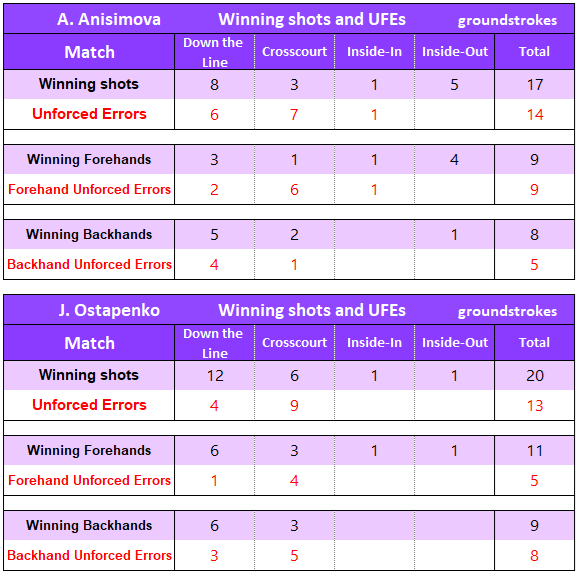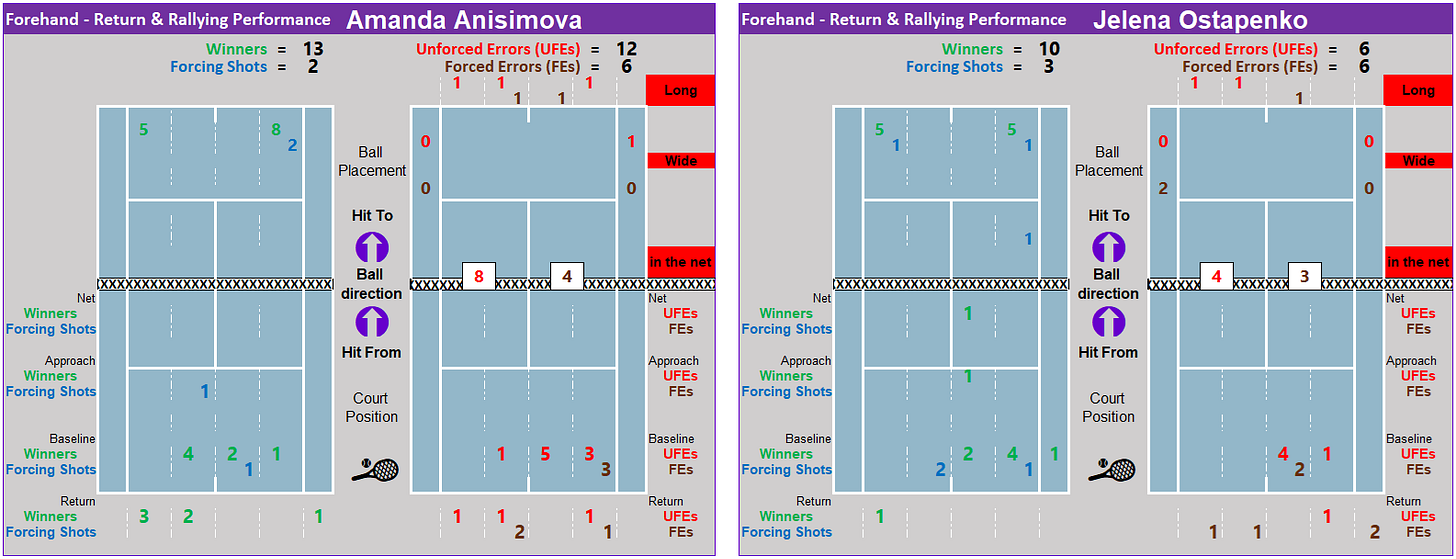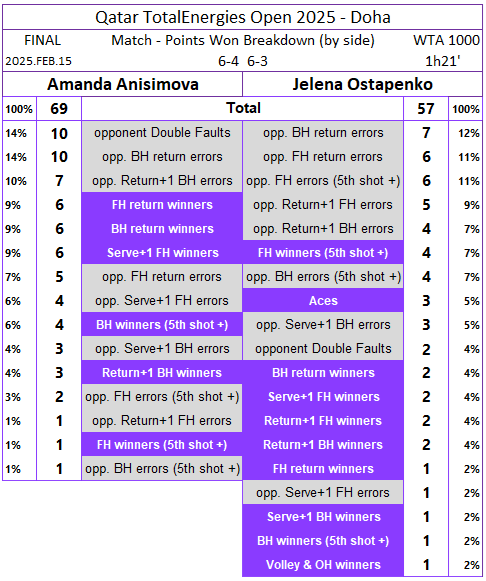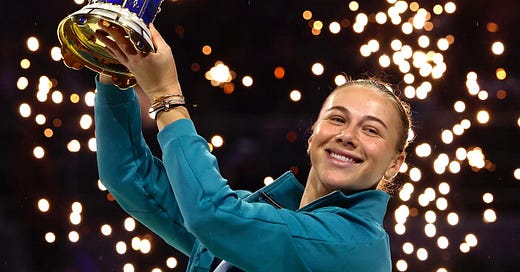WTA1000 Doha: Amanda Anisimova vs Jelena Ostapenko final analysis
Ostapenko missed too many 2nd serves; Anisimova made many 1st serves and her potent return did the rest as she became WTA 1000 champion
Amanda Anisimova (WTA #40) defeated fellow unseeded Jelena Ostapenko (WTA #35) 6-4, 6-3 in the WTA 1000 Qatar TotalEnergies Open final to capture her highest-level title to date.
It may have taken longer than anticipated but Anisimova is a WTA 1000 champion and has cracked the Top-20 for the very first time — the title run lifted her to a career-high #18.

In 2019, a 17-year old Anisimova was confirming her prodigious talent when she clinched her maiden Tour title in Bogotá and followed it up with a breakthrough run to the Roland Garros semi-finals that included wins over 11-seed Aryna Sabalenka and reigning champion Simona Halep.
The young American looked destined for stardom but her career changed course in the cruelest of ways. Right before the start of the 2019 US Open, Anisimova’s father and long-time coach, Konstantin Anisimov, passed away due to a heart attack.
It took time for Anisimova to heal and regain her joy on the court. It also took a ‘reset as a human’ as well as some invaluable growing up, done during a 7-month break from the Tour in 2023 and spent at home with friends and family while living a normal day-to-day life.
When Anisimova returned to the Tour at the start of the 2024 season, she did it on her terms. Feeling refreshed and happy again on the tennis court, it was only a matter of time until she realized her sublime ball-striking talent.
It nearly happened last year in Toronto but Anisimova fell at the last hurdle to Jessica Pegula, after knocking out 4 seeded players — including Sabalenka once more, against whom Anisimova holds a 5-2 record.
Anisimova’s triumphant moment finally arrived on Saturday, when she became the lowest-ranked champion at the Qatar Open as well as the first player to defeat 5 Top-30 opponents since the tournament’s inception in 2001. Anisimova was also just the second American to capture the Doha title, after Monica Seles in 2002. The great Serena Williams reached the 2013 final in her lone participation but lost to Victoria Azarenka. Coincidentally, Azarenka was the first player beaten by Anisimova in her memorable path to long-awaited glory.
While Anisimova joined the elite club of WTA 1000 champions, Ostapenko will have to continue her quest for membership. The Latvian dropped to 0-3 in finals at WTA 1000 level, having lost the 2016 Doha, 2018 Miami and 2025 Doha title deciders.
Ostapenko loves playing in Qatar and credits her run to the 2016 final as the kick-start to her stunning 2017 Roland Garros title. Will she be able to build on something similar, this time around?
If you read our analysis of the semi-final between Ostapenko and Iga Swiatek, you may remember that serve and return performances were the difference-makers in that match (more here).
The Qatar Open final, featuring two aggressive returners, also came down to serve and return performances but in a distinctive way.
A very calm and composed Anisimova focused on giving Ostapenko few chances to swing big by landing a lot of 1st serves in court. The eventual champion ended at 70% (40/57) of 1st serves made and limited her opponent to just 3 return winners.
By contrast, Ostapenko landed fewer 1st serves (58%, 40/69) and, worst of all, struggled mightily with her 2nd serve. Once double faults began falling — a total of 10 in 29 2nd serve points — she took speed off her deliveries, which left her serves shorter and even more exposed to Anisimova’s aggression. The American pounced on them and finished with an incredible 12 return winners, a huge haul that accounted for almost half of her winners in the match (12 of 26).
Not only was the total number impressive, several of Anisimova’s return winners were ripped on big points: 4 of her 5 converted breaks points, championship point included, were all won with return winners!
When we break down points by rally length, double faults correspond to 0-shot points while return winners are assigned to 2-shot points. It was precisely from those 2 metrics that Anisimova extracted all she needed to win each set.
In the opener, the American put together a combined 11-2 score in points won lasting 0 or 2 shots (marked by red boxes, below). The resulting 9-point advantage was larger than her 6-point winning margin at the end of the set (32-26).
The second set also ended with a final 6-point gap (37-31). This time, Anisimova’s advantage in 0- and 2-shot points won grew to 11 points, from a combined 18-7 score (marked by blue boxes, below). Ostapenko managed to win the 4 longest rallies of the set but it was to no avail as her deficit was too large to overcome.
Anisimova’s performance in the final was remarkably balanced in terms of what she produced on return but also from each wing. Everything that Ostapenko failed to accomplish on the day.
On return, Anisimova’s 12 return winners were very close to neutralizing her 13 missed returns (9 of those errors were forced by quality serves from Ostapenko).
Ostapenko was far from compensating 15 return errors (10 were forced errors) as she only countered with 3 return winners.
In the end, return performances were 11 points apart: Anisimova at -1 and Ostapenko at -12.
Return Performances
Anisimova: 12 winners / 13 errors = -1
FH: 6 winners / 6 errors = 0
BH: 6 winners / 7 errors = -1
Ostapenko: 3 winners / 15 errors = -12
FH: 1 winner / 5 errors = -4
BH: 2 winners / 10 errors = -8
Overall, Anisimova concluded the Qatar Open final hitting as many forehands as backhands: 70 and 69, respectively. Significantly, she finished with matching outputs from each wing: 13 winners and 18 total errors.
By contrast, Ostapenko’s backhand was a lot more targeted by Anisimova’s 1st serves (in 32 of 40 1st serves, or 80%) and during rallies (in 41 of 76 rally shots, or 54%). As a result, she struck 80 backhands and 52 forehands.
That strategy paid off for Anisimova since Ostapenko performed 13 points worse from the backhand side compared to her forehand (-15 to -2) and 10 points worse than any of Anisimova’s wings (-15 to -5).
Forehand Performances
Anisimova: 13 winners / 18 errors = -5
Ostapenko: 10 winners / 12 errors = -2
Backhand Performances
Anisimova: 13 winners / 18 errors = -5
Ostapenko: 6 winners / 21 errors = -15

It was already mentioned that Anisimova served to Ostapenko’s backhand in 32 of 40 1st serves (80%), as you may confirm below.
Ostapenko’s primary option was to serve down the T, using it in 23 of 40 1st serves made (58%).
Unfortunately for the Latvian, her serving performance won’t be remembered for that but for her 10 double faults.
All but one of those 10 double faults were coughed up on Deuce side points; 4 occurred when the game score was tied — leaving Anisimova with 0/15 or 15/30 leads — and another 3 were even more inopportune as they created break point chances. Tough to recover from so many mishaps!
A distinctive feature of Anisimova’s excellent return performance was that the majority of her return winners (10 of 12, 83%) were blasted from the AD side (highlighted by red box on the left, below).

It is easy to speculate a connection between these outstanding albeit uneven numbers with Ostapenko's also uneven share of double faults per court side: Anisimova saw fewer Deuce side 2nd serves so it was expectable that she would finish with fewer return winners from that court half.
However, there was probably something extra related to Anisimova’s superior AD side return production because 4 of her 10 AD side return winners were shot off 1st serves.
Anisimova’s AD side return winners
vs 1st serves: 4
vs 2nd serves: 6
Let’s take note on that for future meetings between these two…
When Ostapenko served 3-5 down in the second set trying to extend the final, that last game turned into a great summary of the final. There were a couple of Ostapenko double faults to advance the score to 0/15 and to 15/30. Then, Anisimova’s return took over. She fired a forehand return winner to set up double championship point and clinched the title with a backhand return winner. Fitting!
There is no better way to wrap up this analysis than to show all return winners ripped by newly-crowned Doha champion Anisimova during the final.
📺 source: WTA Tv
Amanda Anisimova (WTA #40) vs Jelena Ostapenko (WTA #35)
2025 Doha final - Match Data
Set by Set Stats
Strategy Stats
Points won by rally length
Rally length
Winners and Errors (returns and rally shots)
Direction of winning shots and unforced errors (only groundstrokes)

Serve and Return
Return & rallying performance



Points won breakdown
This final section gives a last, broader look at the match by presenting how each player won points. Points are listed according to their frequency (highest to lowest) and are named in relation to the last touch on the ball. For simplicity, groundstrokes hit from the 5th shot onwards are grouped together.
Breakdown by side (FHs or BHs)

Breakdown by error type (UFEs or FEs)

To find out more about the stats published here, please visit the following post.
While we follow the same criteria used on all major tennis events, our stats are collected through our own video analysis and are not official WTA or ITF stats.
Thanks for reading!
— Tennis Inside Numbers














